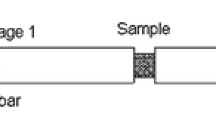Abstract
The effect of temperature and strain-rate on the fracture behaviour during high strain-rate (∼ 103 sec−1) impact of two highly filled polymeric composite propellants (containing segmented polyurethanes based on hydroxy-term inated polybutadiene (HTPB) or glycidyl azide polymer (GAP) filled with ammonium perchlorate (AP) particles) and a plasticized thermoplastic (cast double base (CDB) nitrocellulose-nitroglycerine) propellant have been examined over a wide temperature range encompassing the ⋊ittle-ductile” transition. In the “elastic” region of the loaddisplacement curve, the yield stress and fracture toughness is highest for GAP/AP and lowest for HTPB/AP. In the “elastic” and post-yield “ductile” regions CDB is more fracture-resistant than GAP/AP and HTPB/AP over the temperature range −20 to 50° C, but below −40° C, where both CDB and GAP/AP are brittle, GAP/AP is more fracture-resistant than CDB (as observed in the “elastic” region). Although all the propellants are known to develop small cracks in the “elastic” and post-yield “ductile” regions of the load-displacement curve, the overall fracture behaviour is largely governed by viscoelastic properties (because the cracks close up in compression). The good mechanical properties of CDB, above the “brittle-ductile” transition temperature, can be attributed to the presence of a largeβ-transition loss peak. In the composites, the fracture behaviour is also influenced to a lesser extent by the degree of filler-binder interactions. Dynamic mechanical analysis indicates that GAP/AP has a slightly higher degree of filler-binder interactions than HTPB/AP. A temperature-strain rate reduction has been obtained for the yield stress and the composite curve can be expressed by the equation σy =K 1 +K 2 log (Ġea T ) whereK 1 andK 2 are constants anda T is a shift factor.K 2 is a material constant which reflects the temperature and strain-rate sensitivity.
Similar content being viewed by others
References
C. W. Fong andR. C. Warren,J. Mater. Sci. 20 (1985) 3101.
K. G. Hoge,Appl. Polym. Symp. 5 (1967) 19.
J. Heijboer,J. Polym. Sci.: C 16 (1968) 3755.
P. I. Vincent,Polymer 13 (1972) 558.
P. Kendall,Br. Polym. J. 10 (1978) 35.
G. T. Wulf andG. T. Richardson,J. Phys. E: Sci. Instrum. 7 (1973) 167.
S. Y. Ho andC. W. Fong,Polymer in press.
R. F. Boyer,Polym. Eng. Sci. 8 (3) (1968) 161.
P. I. Vincent,Polymer 15 (1974) 111.
B. L. Lee andL. E. Nielsen,J. Polym. Sci: Polym. Phys. Edn 15 (1977) 683.
L. E. Nielsen andB. L. Lee,J. Comp. Mater. 6 (1972) 136.
Author information
Authors and Affiliations
Rights and permissions
About this article
Cite this article
Ho, S.Y., Fong, C.W. Temperature dependence of high strain-rate impact fracture behaviour in highly filled polymeric composite and plasticized thermoplastic propellants. J Mater Sci 22, 3023–3031 (1987). https://doi.org/10.1007/BF01086508
Received:
Accepted:
Issue Date:
DOI: https://doi.org/10.1007/BF01086508




